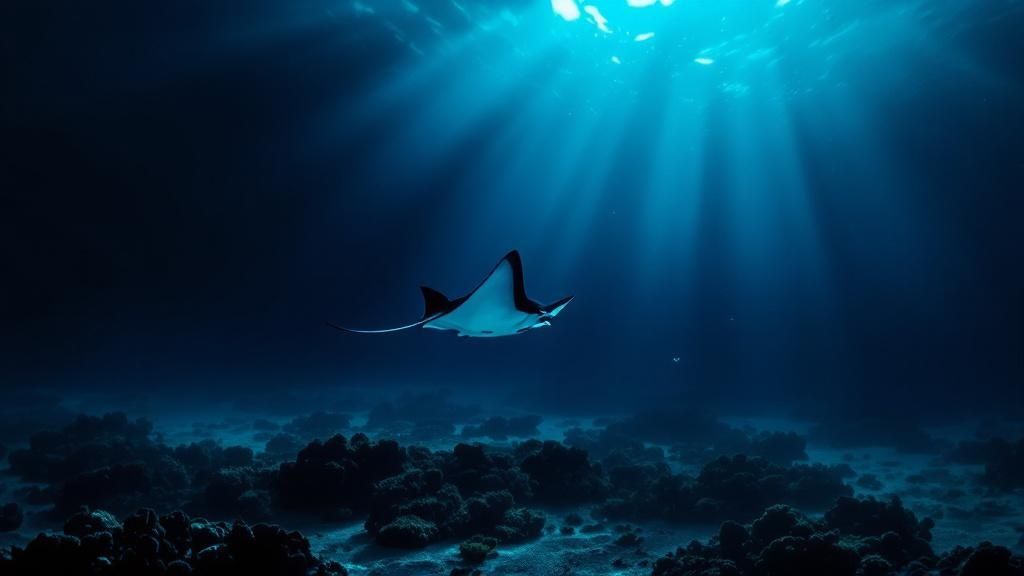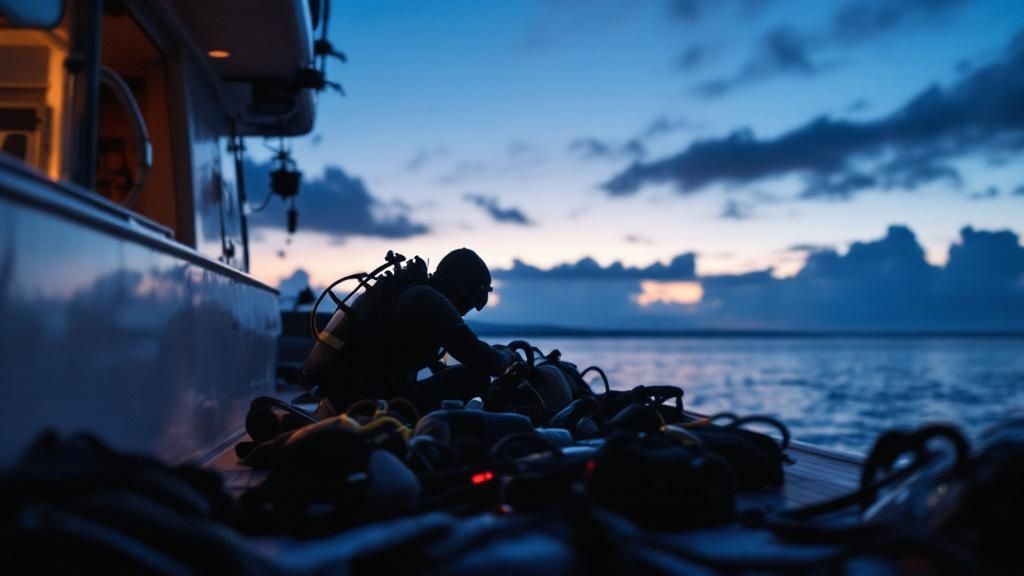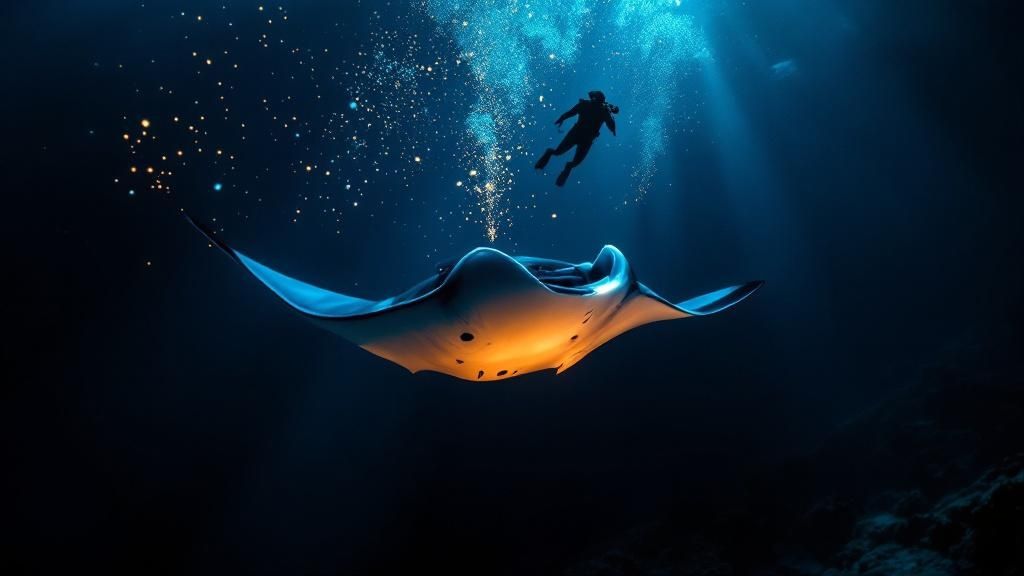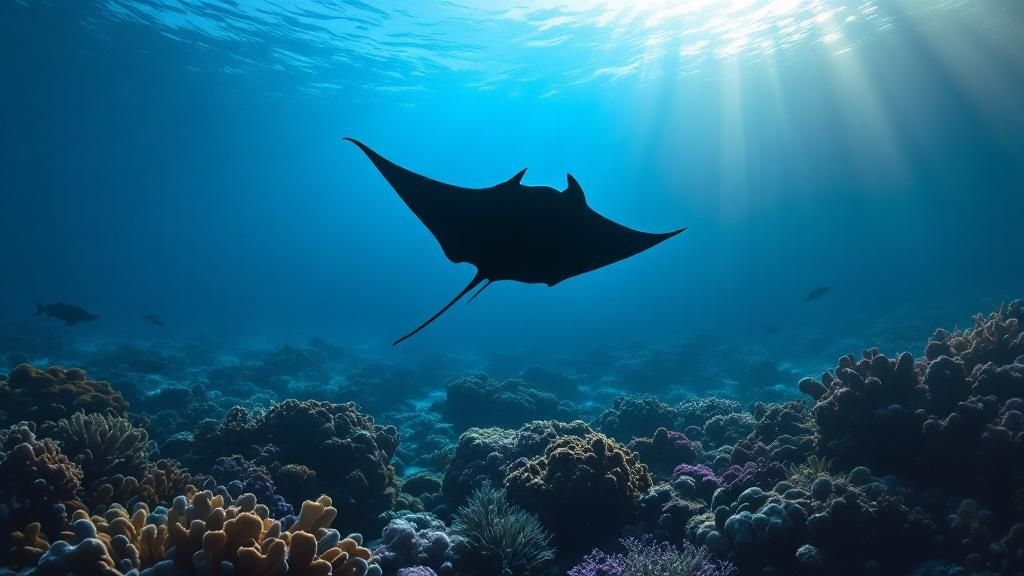Imagine getting just inches away from a gentle giant of the sea. That’s not a once-in-a-lifetime-if-you're-lucky scenario here. The Kona manta ray dive delivers one of the most reliable and genuinely awe-inspiring wildlife encounters on the entire planet. It’s an almost nightly underwater ballet, and frankly, it's a must-do for anyone visiting the Big Island.
Why Is Kona the World Capital for Manta Rays?

Let's be clear: Kona isn't just a great place to see manta rays; it is the place. This isn't by accident. A perfect storm of geography, biology, and a little bit of history has created the ideal stage for this incredible nightly show. The calm, protected waters along the Kona coast are a dream for both the mantas and the divers who flock here to see them.
The secret sauce is the plankton. Kona's unique coastal geography and nutrient-rich currents create a dependable, all-you-can-eat buffet for these massive filter-feeders every single night. This is precisely why the sighting success rate is so high, often topping 90% year-round. While other famous dive destinations have seasonal sightings, Kona’s manta population is resident—they live here, and they're not going anywhere.
The "Campfire" Effect: How the Magic Happens
The entire Kona manta ray dive experience hinges on a clever setup known as the "campfire" effect. After sunset, dive operators place powerful, yet eco-friendly, lights on the ocean floor. These lights act like a magnet for phytoplankton and zooplankton, creating a dense, glowing cloud of manta food.
Drawn in by this easy meal, the mantas glide effortlessly through the beams of light. You'll watch them perform graceful barrel rolls and swoop just over your head, mouths wide open to scoop up as much plankton as they can. It’s this predictable feeding behavior that allows for such breathtakingly close encounters.
This isn’t some random encounter in the deep blue. It’s a well-understood ecological phenomenon that turns a patch of dark ocean into a glowing underwater amphitheater for one of nature's most spectacular shows.
To give you a clearer picture, here's a quick rundown of what makes this dive so special.
Kona Manta Ray Dive at a Glance
Here’s a quick overview of what makes the Kona manta ray dive a must-do experience, helping you understand the key elements at a high level.
| Aspect | Details |
|---|---|
| Location | Kona Coast, Big Island, Hawaii |
| Success Rate | Over 90% sighting probability year-round |
| Best Time | All year; encounters are not seasonal |
| Key Attraction | Dozens of resident reef manta rays |
| The "Campfire" | Underwater lights attract plankton, which then attracts mantas |
| Conservation | A model for sustainable ecotourism with strict guidelines |
| Manta Population | Over 290 individually identified mantas since 1991 |
This table just scratches the surface, but it highlights why this isn't just any dive—it's a world-class wildlife interaction backed by decades of research and conservation.
A Legacy of Sustainable Ecotourism
This world-famous dive didn't just pop up overnight. It has a rich history rooted in a deep respect for the animals. Since 1991, local divers and researchers have been photographing the unique spot patterns on the mantas' bellies, which work just like human fingerprints.
The very first identified manta was nicknamed 'Lefty.' Today, the catalog has grown to over 290 unique individuals! This long-term citizen science project has been instrumental in understanding and protecting these animals. It’s fostered a community dedicated to their well-being, leading to strict, effective guidelines that all tour operators follow to keep the mantas safe.
When you go on a manta ray night dive, you're doing more than just having an adventure. You're becoming part of a successful conservation story, witnessing firsthand how tourism and marine protection can work together beautifully.
Choosing Your Ideal Manta Ray Tour
With so many fantastic operators in Kona, picking the right manta ray tour can seem like a tough choice. But it really boils down to one key question first: do you want to snorkel or scuba dive? Each gives you a completely different, yet equally breathtaking, perspective on this underwater ballet.
Snorkel vs. Scuba: A Tale of Two Views
Snorkeling is an incredible option, especially if you have non-divers in your group or you're not certified yourself. You'll float comfortably on the surface, usually holding onto a large, custom-built raft. Powerful lights are attached to the bottom of this raft, shining down into the dark water to create a "campfire" effect that attracts plankton. The mantas follow the food, and you get an amazing bird's-eye view as they glide and feed just inches below you.
For certified divers, the experience is completely different. You’ll descend to a sandy patch on the ocean floor, typically around 30-40 feet deep, and find a spot to kneel or sit. From there, you become part of the light show, aiming your dive light straight up to help build the plankton cloud. The reward? Mantas swooping and barrel-rolling right over your head in a display that feels truly otherworldly. If you're wondering what all the fuss is about, you can learn more about what makes this dive so special.
Here’s a quick breakdown to help you decide:
| Consideration | Manta Ray Snorkeling | Manta Ray Scuba Diving |
|---|---|---|
| Viewpoint | Top-down view from the surface | Bottom-up view from the ocean floor |
| Certification | No certification required | Scuba certification is mandatory |
| Proximity | Mantas glide inches below you | Mantas swoop directly over your head |
| Best For | Families, beginners, non-swimmers | Certified divers looking for total immersion |
Picking the Right Spot
Next up is the location. The two main, officially recognized sites for the manta ray dive kona are Manta Village and Manta Heaven (also called Garden Eel Cove).
Manta Village, just off the coast from the Sheraton Keauhou Bay, is the original location and is known for its remarkably consistent sightings. Manta Heaven, located further north near the airport, can sometimes draw in a bigger crowd of mantas, making for a truly spectacular show. Don't stress too much over this choice, though—your tour operator will almost always pick the best site based on that day's ocean conditions and where the mantas have been most active.
Smart Questions to Ask Before You Book
The manta ray dive is a huge draw, bringing in about 80,000 people every year thanks to a consistent 80% to 90% sighting rate. But with that popularity comes a responsibility to choose an operator who puts safety and conservation first.
My biggest piece of advice? Ask your tour operator about their guide-to-guest ratio. A smaller group per guide almost always translates to a safer, more personal, and ultimately more enjoyable time in the water.
Before locking in your reservation, get a feel for the company by asking a few key questions:
- Do you have a "manta guarantee"? What happens if we don't see any rays?
- Are you a Manta-Safe certified operator and do you follow all interaction guidelines?
- What kind of safety gear do you have on the boat and in the water?
- How much time do we actually get in the water with the mantas?
The answers will tell you a lot about their professionalism and commitment to both you and the animals. And remember, while most people book a single night dive, you can also find more extensive trips like liveaboard diving that let you fully immerse yourself in Hawaii's underwater world.
Getting Ready for Your Manta Ray Night Dive

A little bit of prep work goes a long way, especially when you’re about to slip into the dark ocean at night. Being comfortable, warm, and confident before you even leave the harbor is the real secret to soaking in every moment of your manta ray dive in Kona. This is your personal pre-dive checklist for an unforgettable night.
While most tour operators will have you covered with all the essential scuba or snorkel gear—wetsuits, fins, lights, the works—there's one piece of equipment that can truly make or break your experience: your mask. Nothing yanks you out of a magical moment faster than a leaky, ill-fitting mask that you have to constantly clear.
Trust me on this one. Bringing your own mask that you know fits your face perfectly is the single best investment you can make for this trip. If you don't have one, pop into a local dive shop in Kona before your tour. The folks there are pros at finding the perfect fit. For a deeper dive, check out our guide on the gear you will need for your Kona diving adventure.
What to Wear and What to Pack
Beyond your dive gear, a few personal items are essential for staying comfortable. Even on a warm Hawaiian evening, the boat ride back to the harbor can feel surprisingly chilly once you’re out of the water and the wind picks up.
Toss these items in a dry bag to make the trip back a whole lot more pleasant:
- A Warm Jacket or Hoodie: This is non-negotiable. A windbreaker or a cozy fleece will be your best friend on the ride home.
- A Dry Towel: You’ll be so glad you have something to dry off with as soon as you climb back on board.
- Reusable Water Bottle: Saltwater is dehydrating, so keeping a water bottle handy is always a smart move.
- A Change of Dry Clothes: Swapping your wet swimsuit for dry clothes can make all the difference in your comfort.
This small "comfort kit" ensures you can relax and bask in the afterglow of your incredible encounter instead of shivering all the way back to shore.
One of the most common mistakes I see is people underestimating the post-dive chill. The wind whipping across a moving boat when you're wet can drop your body temperature fast. Packing warm layers is a pro move that separates the rookies from the veterans.
Fueling Your Body and Avoiding Seasickness
What you eat—and what you don't—before your tour can have a surprisingly big impact on your comfort, especially if you’re prone to motion sickness. The best bet is to have a light meal a couple of hours beforehand. Steer clear of anything too heavy, greasy, or acidic.
If you know you’re susceptible to seasickness, don't leave it to chance. Grab an over-the-counter remedy like Dramamine or Bonine. The trick is to take it at least an hour before you get on the boat so it has time to kick in. If you wait until you start feeling queasy, it’s already too late.
With these simple steps out of the way, you’re all set for a smooth, comfortable, and absolutely mind-blowing night with Kona's gentle giants.
What to Expect During Your Manta Encounter

As the last sliver of sun disappears below the horizon, your boat will anchor, and the real excitement starts to build. Your guide will gather everyone for one last, vital briefing. This isn't just a routine speech; it’s the key to making sure the manta ray dive kona is safe and respectful for both you and these magnificent animals.
They'll run through everything, from the best way to slip into the dark water to exactly where you'll be positioned once you’re in. You’ll also go over the strict rules of engagement—the absolute foundation of what makes this ecotourism experience so successful. Once the briefing is done, it's time to gear up and prepare for one of the most incredible moments you'll ever have: entering the warm, dark Pacific Ocean at night.
The Underwater "Campfire"
Once you're in the water, the show begins. Your guide will lead you to your spot—you'll either be holding onto a specially designed float board if you're snorkeling or settling on a sandy patch on the ocean floor if you're diving. The whole experience centers around a brilliant concept known as the "manta campfire."
Powerful, eco-friendly lights are set up to illuminate a specific area. For snorkelers, these lights are attached to the float board, shining down into the depths. For divers, everyone sits in a circle on the bottom and points their dive lights straight up. This concentrated beam of light quickly attracts a dense cloud of plankton, creating a glowing, all-you-can-eat buffet.
It’s this simple but ingenious setup that makes the Kona encounter so reliable. The mantas, drawn by the promise of a free meal, glide in from the darkness to feast.
The first time a manta ray appears is something you'll never forget. It materializes out of the blackness like a silent phantom, its massive wings propelling it with impossible grace. In that moment, you stop being a spectator and become a part of their world.
The Rules of Engagement
To keep these encounters sustainable and safe for everyone, there are a few non-negotiable rules. The big one is: do not touch the manta rays. Their skin has a delicate mucus layer that protects them from infections, and touching them can strip it away, causing serious harm.
Here are the key guidelines you absolutely must follow:
- Be a passive observer: Never chase or try to ride the mantas. Let them control the interaction.
- Hold your position: Stay in your designated spot. This creates a predictable and safe space for the mantas to swim.
- No diving down: If you're snorkeling, stay on the surface. Free-diving into their feeding zone is strictly prohibited.
This carefully structured approach is why the experience is so consistent and why Kona is considered one of the best solo travel destinations for wildlife encounters for marine lovers.
The dedication to these animals goes beyond just the tours. Between 2009 and 2014, local videographers kept meticulous records, tracking individual mantas and their health. Your participation supports these ongoing conservation efforts. You can learn even more about what the manta ray night dive involves on our blog.
Tips for Photographing Manta Rays at Night
Trying to capture the ethereal beauty of a manta ray dive kona is a goal for almost everyone on the boat, but let's be honest: underwater night photography is tricky. The great news? You don't need a thousand-dollar camera rig with giant strobes to get shots you'll be proud of. A simple action camera, like a GoPro, can work wonders if you know how to use it.
The single biggest mistake I see divers make is firing their camera's built-in flash. All this does is light up the millions of tiny plankton particles floating right in front of your lens, creating a nasty "blizzard" effect known as backscatter. Just turn it off. Instead, let the powerful lights from the dive operator do all the heavy lifting for you. Try to position yourself where that main light source hits the mantas from the side or below. This creates beautiful, dramatic shadows and really makes their graceful shapes pop.
Dialing in Your Camera Settings
Getting your settings right before you even get wet is half the battle. If your camera has manual controls, a good starting point is a higher ISO (around 1600-3200). This makes the camera's sensor more sensitive in the dark. You'll want to pair that with a slower shutter speed, maybe 1/60th of a second, to capture that silky smooth motion without turning the manta into a total blur. Open up your aperture as wide as it will go (f/2.8 or lower) to let in every possible photon of light.
If you're using a GoPro, my best advice is to forget photos and just shoot video. Video modes are naturally better at handling low light, and you'll do a much better job capturing the hypnotic, ballet-like dance of the mantas anyway.
- Resolution & Frame Rate: Always shoot in at least 4K at 30fps. This gives you fantastic-looking footage and the flexibility to pull high-quality still images from your video when you're back on land.
- Stabilization: Turn your stabilization (like HyperSmooth or RockSteady) to its highest setting. It works wonders to smooth out the inevitable shakiness from being in the water at night.
- Field of View: Go wide. A wide or super-wide field of view is essential for capturing the sheer scale of the scene when these gentle giants glide right over you.
Remember, you're a guest in their dining room. Let the mantas come to you. The most breathtaking shots happen when you stay still on the bottom and a manta ray glides just inches over your head, perfectly framed against the dark water.
The Right Gear and a Patient Approach
Of course, the gear you bring makes a difference. A camera known for strong low-light performance will give you a leg up, and it's worth doing a little homework on choosing the perfect action camera for your dive before you go.
Finally, think beyond just pointing your camera at the nearest manta. Think about composition. Try to frame your shot with other divers in the background to create a real sense of scale. Capture that incredible moment when their massive mouths open wide as they filter-feed in the beams of light. A little patience and a smart use of the boat's lights will ensure you go home with photos and videos that truly capture the magic of the night.
Answering Your Manta Ray Dive Questions

It’s completely normal to have a few last-minute questions, even after you’ve planned everything out. After all, getting in the dark ocean with giant, gentle creatures isn't your everyday activity! I've been doing this for years, and I still get a thrill. Let's clear up some of the most common things people ask before they take the plunge.
When Is the Best Time of Year to Go?
This is the best part: there really isn't a bad time. The Kona manta rays are year-round residents. They don't migrate, so they're here feeding along the coast every single night. Because of this, the experience has an incredible 90% year-round success rate.
So, you can book your trip in January or July and have a fantastic shot at an unforgettable encounter. The main thing that changes isn't the mantas, but the ocean itself. If you're looking for the absolute calmest sea conditions, the summer months from May through September are typically your best bet.
Is the Manta Ray Dive Safe for Beginners?
Absolutely. This entire experience was designed from the ground up to be safe and accessible, whether you're a seasoned diver or have never even worn a snorkel mask.
- For Snorkelers: You don't need to be an Olympic swimmer. You'll hold onto a large, custom-built floatation board that has powerful lights shining down into the water. All you have to do is float and watch the show right below you. It's incredibly stable and safe.
- For Divers: Many people do this as their very first night dive, and it's perfect for it. The dive is shallow and stationary—you'll just be kneeling or sitting comfortably on the sandy bottom. Every good operator starts with a detailed safety briefing and has expert guides right there in the water with you.
What Happens if No Mantas Show Up?
While sightings are almost a sure thing, we have to remember these are wild animals on their own schedule. Nature is unpredictable, and on very rare nights, the mantas just don't feel like coming to dinner. It happens.
This is where booking with a quality, reputable operator is so important. Most of the top companies offer what's called a "manta guarantee."
If you don't see any mantas on your tour, they'll let you come back and try again on another night for free, usually on a space-available basis. You'll want to confirm this exact policy before you book.
Here's a pro tip: try to schedule your manta dive for one of your first nights in Kona. That way, if you happen to draw the short straw, you have plenty of time to reschedule during your trip.
Can I Touch the Manta Rays?
The answer to this is a firm, absolute no. This is the most important rule of the entire encounter, and it's for the health of the mantas.
A manta ray’s skin is coated in a delicate, protective mucus layer. Think of it as their immune system, shielding them from bacteria and parasites. Touching them, even with the lightest brush of a finger, can strip away this crucial protection and leave them vulnerable to serious infections.
The whole point of this dive is passive observation. We're just visitors in their world. By keeping your hands to yourself, you play a direct role in protecting these magnificent animals and ensuring this incredible experience can continue for decades to come. For a deeper dive into all the essential rules and tips, we've put together a complete guide on what you should know about the manta ray dive in Kona.
